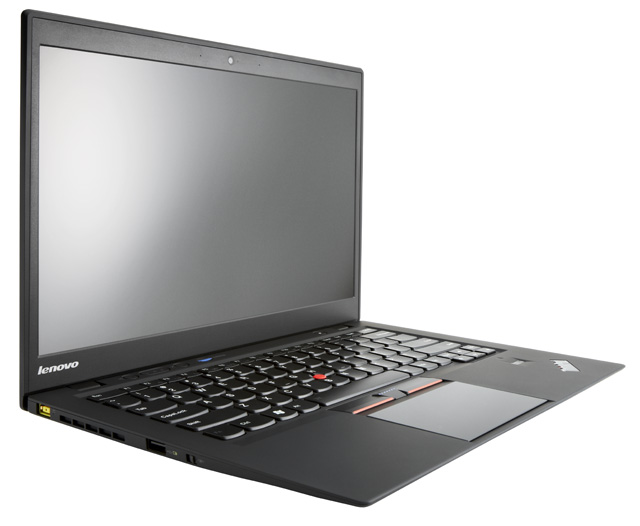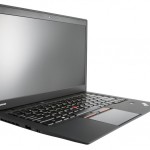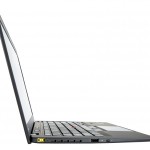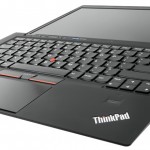
news Chinese manufacturer Lenovo yesterday confirmed the newest ‘Carbon’ version of its popular X1 ThinkPad laptop was available in Australia — but for a price 60 percent more expensive than it is sold for in the US, or around $755 more.
The ThinkPad X1 Carbon is the newest version of the ThinkPad X1, billed as one of Lenovo’s top-end machines and a popular device in Australia’s business market due to the long-standing build quality of Lenovo’s laptops and their suitability for hard-wearing corporate use. The new model has been constructed with carbon fibre to make it “the world’s lightest 14″ business-class” laptop in the Ultrabook class, according to Lenovo — coming in at 1.36kg.
It features a third-generation Intel Core i5 or i7 CPU running at speeds of between 1.7GHz and 2GHz, an Intel HD Graphics 4000 video chip, up to 8GB of DDS3 memory running at 1333MHz, a 720p HD webcam, up to 256GB of SSD SATA3 storage, Dolby Home Theater v4 sound, a fingerprint reader and a number of other high-end specifications. The 14″ screen can run at a resolution of 1600×900 pixels. The X1 also features a focus on battery life, including a so-called ‘Rapidcharge’ feature which can quickly recharge up to 80% of the laptop’s battery life in just 35 minutes.
The announcement of the X1 Carbon marks the kick-off of the ThinkPad brand’s 20th anniversary celebrations, according to the company and “epitomises Lenovo’s focus on innovative design, business-class performance and catering to the needs of today’s businesses, both enterprise and SMB”.
“Very few brands are fortunate enough to have built a strong following that is passionate about each generation of ThinkPad products,” said Alan Munro, managing director, Lenovo ANZ. “With that in mind, we’re excited to debut the ThinkPad X1 Carbon in Australia. We feel it meets the demand for an extremely thin and light laptop, with the performance users need to accomplish professional business goals.”
“To date, the thin and light nature of Ultrabooks has often rendered the products delicate and fragile,” the company said. “However, created with carbon fibre similar to what is used to engineer Formula 1 racing cars, the X1 retains ThinkPad’s renowned durability while weighing just 1.36 kilograms. With the addition of the new Carbon Fibre top cover, the X1 Carbon’s exterior cover acts as an extra strong roll cage, protecting internal components and the entire chassis from damage. Similar to previous ThinkPads, the X1 Carbon has passed eight military grade spec tests for heat, cold and dust etc. ensuring it is robust and suitable for a range of environments.”
Delimiter’s review of the previous X1 was overall very positive, but with a caveat about battery life. Reviewer Jenneth Orantia wrote in September last year:
“There’s a lot to like in the latest flagship ThinkPad. The premium materials, semi-rugged construction, and ultra-slim profile all amount to a beautifully-engineered laptop that’s more than capable of handling the day-to-day drudgeries of office work. This is a first-class machine that offers almost everything a mobile professional would want in a notebook. Unfortunately, the one thing it does lack, long battery life, is a significant compromise that we’re not sure many road warriors will be happy to make. For this class of notebook, we’d expect battery life to be twice as long at least.”
“If you do most of your work in the office, and only move around for the occasional meeting, the ThinkPad X1 offers a fabulous user experience that few other notebooks match. But if you need a machine that will last for long stretches away from the charger, there are other ultraportables that are much better suited for the job.”
However, one aspect of the X1 which buyers may find frustrating is the laptop’s pricing.
“Pricing for the Lenovo ThinkPad X1 Carbon will start at AU$1,999 including GST, and is available now through Lenovo’s business partners and via www.lenovo.com.au. The ThinkPad X1 Carbon comes equipped with a three year warranty,” the company said in its statement yesterday. However, the US model is available at a substantially cheaper prices — starting at US$1,299, or AU$1,244.
The pricing mimics the price increase on the original X1, which sold for $560 more than the same hardware in the United States. When it launched the original X1 in Australia last year, executives defended the pricing by saying the company priced “at the local market”, not based on what the value of the Australian dollar was compared to the US. At the time, one Australian dollar bought $1.06 US dollars — now it buys $1.04 US dollars.
The logistical cost of bringing machines to the Australian market was greater than in the US, the company said, in addition to an enhanced cost of servicing Australia’s dispersed population. Lenovo Australia managing director Alan Munro said last year that the “sheer size of supply” to locations such as the US or Europe brought economies of scale. And costs outside the cities added up. “It’s the most urbanised country in the world — if you’re outside the urban area, it costs more,” he said of Australia. “There will be fluctuations in pricing from country to country,” said Lenovo product lead David Heyworth last year. “We try to ensure they are as minimal as possible. There are service and support issues that we need to maintain here.”
However, another major manufacturer, Apple, has broadly harmonised the Australian prices of its MacBook laptop line with its US pricing. The laptops compete directly with Lenovo’s ThinkPad line and are increasingly popular in corporations. The news comes as Federal Parliament is currently holding an inquiry into pricing markups on technology goods and services sold by international suppliers in Australia, with Lenovo one company which has come under the spotlight in the process. Lenovo has not made a submission to the inquiry.
opinion/analysis
The ThinkPad X1 Carbon looks like a damn fine laptop, and I’m looking forward to getting it into the Delimiter labs for testing. However, I can’t believe the amount which Lenovo is charging Australians for this device. a 60 percent market is just not justifiable on laptops like this, as Apple has shown with its price harmonisation. I call upon Lenovo to follow Apple and harmonise its Australian pricing with that of the US — or at least bring it within 15 percent or so. A $755 Australian markup on a single laptop is just a bad joke — and I think everyone in the IT industry is aware of that fact by now.
Image credit: Lenovo




Arghh, Tonys carbon tax warning were correct!!! ;-)
LOL, my immediate thought too!
Support Australian Jobs!
Support Australian Retailers!
It’s because we have to blame GST, and clearly we are further away from China (the manufacturer) than America.
Blame Julia for Carbon tax!
No way. Please don’t support Australian business if they cannot compete with the price elsewhere. This is a free market. Australian businesses are hungry with high markups and they screw you over and over.
I will buy the notebook rather in US. For AUD$700 I can go on holidays.
If you stop buying it here the prices will go down.
Have a nice day.
Apple’s is the cheap, affordable option for the people.
The world’s gone upside down.
I know, right??
The laptops compete directly with Apple’s ThinkPad line and are increasingly popular in corporations.
I think you need a coffee mate :)
oops. Will fix :)
“a 37 percent market is just not justifiable”
Double shot espresso!
Wasn’t there recent scrutiny over this sort of pricing arrangement? I’m sure that charging what the market can tolerate is common, but gee getting shafted so obviously does tend to sting a bit.
On a lighter note: “I’m looking forward to getting it into the Delimiter labs for testing”
Admit it, the Delimiter lab is just the coffee shop with the prettiest girls… Check the bling hardwares ladies.
Actually it might have been Samsung I am thinking of. Stupid mid afternoon memory is gone on me.
“Priced to the local market”… in other words, if we all us importers and distributors keep prices high noone will undercut anyone else and our profit margins will stay crazy high. This is cartel behaviour – everyone should vote with their $$$ and buy from US through freight forwarder as many ppl like me have. Even in the unlikely event (talking TPs here) if you have to cough up postage to send it back for warranty repair you’re still hundreds ahead!!!
I remember back in the mid 90’s when IBM’s software group was set up that local prices were set by the product manager to be the same in $A as the number in $US so a USD100 product sold for AUD100. I recall that the exchange rate at the time was around 80c US to 1 AUD.
Higher labour costs, much smaller population (thus smaller market, less economies of scale), more stringent consumer protection laws. I can see all that easily accounting for a 37% price difference.
I can’t.
Higher labour costs — what labor? Assembly is done offshore, and so can most support tasks. Locally it’s mainly just distribution (mainly handed by external distributors), some corporate sales, and some marketing and admin. Not a lot of overhead.
Much smaller population — so what? Just ship 100 pallets instead of 1,000 (for example), from China where they’re manufactured. Big deal? I don’t think so.
More stringent consumer protection laws — how does this come into it again?
And the biggest question of all … if Apple can harmonise local pricing, why can’t Lenovo? Lenovo would likely be pretty close to being as large in laptops as Apple is, when you consider how many corporations have massive ThinkPad fleets.
Is it a bird? Is it a plane? No… it can’t be… I think… I think… I think it’s a ThinkPad fleet over yonder horizon!
….
I need sleep.
When your need support or hardware servicing, much of it is done locally. Customers won’t be happy to be told to ship something back to Singapore. Same thing with phone support (at least part of Lenovo’s call centre operation is on-shore). And it’s not just the manufacturer – the wages of local dock workers, truck drivers, couriers etc all add up. Yes they are ‘external’ but those costs have to be borne by someone.
A smaller market means you have a smaller margin of error. It is much harder to estimate demand when aggregate numbers are lower. Costs of variations (like custom configurations) and stock of spare parts are particularly sensitive to market size. It is not a simple linear equation and I am surprised you wave this away so dismissively. If this was easy then there would be no BI industry and SAP wouldn’t be the second-largest software maker in the world.
More stringent consumer protection laws increase the costs for manufacturers because they have to do things they don’t have to do in other jurisdictions. For example they have to provide ‘free’ hardware repairs for a longer period than in the US (at least most US states; some are similar to us) because the wording in our statutory warranty rights is stronger. But of course it’s not ‘free’ – that cost gets passed back to us through higher prices.
Apple have the best supply chain management of any company anywhere – in the future textbooks will cite Apple the way they cite Toyota. Also Apple specifically keep a simple product lineup to help facilitate this – a route that most other manufacturers don’t go down (for better or worse). Apple’s operations are as much a part of their success as anything else. In the same way that manufacturers have trouble keeping up with Apple’s design and engineering, so too do they have trouble keeping up with their supply chain excellence.
Look up the Ikea prices in the US. Or the price of a house in LA vs the price in Sydney. It’s not a Lenovo scam.
“Apple have the best supply chain management of any company anywhere – in the future textbooks will cite Apple the way they cite Toyota.” – Perhaps that is true
“Also Apple specifically keep a simple product lineup to help facilitate this” – This I will agree with, there is the place in Bankstown (Sydney) called Pho An. It’s maybe 15% more expensive than other places that sell Pho Noodle soup, but they are extremely quick, their range is limited (only 10 products?) but portions are very generous and their famous Pho definitely lives up to its legendary taste. From the moment you order at the door, to sitting down to eat, it takes about ONE MINUTE for the food to come, unbelievable!
“In the same way that manufacturers have trouble keeping up with Apple’s design and engineering, so too do they have trouble keeping up with their supply chain excellence.” – Each to their own.
Factors like extra shipping costs, retailer’s wages and support also effect the $500 Asus/Acer laptop. It’s bigger and heavier so should cost more to ship.
How come these laptops don’t cost $755 more than the US counterpart? It can’t be because the business support options cost more (which is an extra add-on in the configuration page on their site), you only get the basic warranty. I can probably pay a technician to disassemble and reassemble the thing, install all the operating systems (ALL of them) and give me a foot rub for that $755.
Only 37%. I could almost wear 37%.
I was waiting for the Dell answer to the Mac Book Pro. Well, the Dell “answer”, as in something that had roughly the same specs that I could run Debian on has arrived in the form of the M4700. 10 hours battery life, 16Gb memory, not a retina display but a still very acceptable IPS 1920×1080 panel, and unlike the Apple heaps of expandability. In this now crazy world I wasn’t expecting it to get it for $2K, which is what a Mac Book Pro with 16Gb, quad core, 512Gb SSD sells for because in this new world order Apple makes the cheapest high end hardware, but neither was I expecting this:
For a Dell M4700, with a 2.6GHz i7-3720QM, 8Gb RAM, 500 Gb HDD, IPS 1920×1080 display, 3 yr warranty.
From http://www.dell.com.au: AUD$3600.
From http://www.dell.com: $1550.
That’s a 230% markup. Meanwhile Apple manages to sell the Macbook Pro at roughly the same price in both countries. It’s enough to make a grown man cry.
Keep up the good work in publicizing these crazy discrepancies.
I have a Lenovo T61 – still going strong apart from the dodgy sony battery that failed after the first 14 months. However, having the [fn] key on the lower left of the keyboard – where the [ctrl] key should be – always drives me crazy. [fn][c] doesn’t copy, [fn][v] doesn’t paste and there is no where in the bios to remap these keys. Maybe its a corporate thing but I would not buy another Lenovo with this key layout.
+1
I eventually got used to the reversed Fn/Ctrl on my Thinkpad SL500, but now it’s a problem whenever I use another laptop. I always hate it when someone pointlessly decides to do their own thing against what everyone else does just to be different.
So Renai care to update the article now that the official price for the X1 carbon is out? And for those wondering, the starting price is 1589, but some smart blokes have managed to find loopholes and get the price down to 1089 dollars. So that is a mark down pf how many per cents compared to US.
What official price?
http://shopap.lenovo.com/au/en/laptops/thinkpad/x-series/x1-carbon/
here you go. The official price of the X1 Carbon starts at $1589.
Lead_org: When will the i7 with 8GB+ RAM option be available in Australia?
Comments are closed.